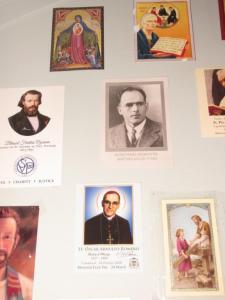Part II
Part III
Part IV-1
Part IV-2
“The public,” writes Orrin Klapp, “indeed, is usually ignorant of its heroes. There are several reasons for this: First, at the time of emergence of a hero the public usually has little opportunity for making direct observations; second, actions have a permanent advantage over traits in commanding interest and attention; third, the public usually infers the traits of a hero from the thing he has done.“[1] What Orrin Klapp wrote about heroes explains how and why the legends about Constantine and Ashoka developed. They are religious heroes; they were seen by their contemporaries as having done something great because, through their own conversion, they helped convert their empires to their new faith (although neither specifically required it, they certainly encouraged others to follow their example. They also did what they could to give their new religious affiliation every advantage they could, donating funds and resources to its leaders, even if not to the extent that the legends suggest).
The historical Constantine and Ashoka, great as they were, did not satisfy the pious expectations of their Christian and Buddhist peers. The creation of the new Constantine and Ashoka placed at the forefront, as Orrin would suggest, what they did; their private, historical life was ignored or forgotten. Time, combined with lack of historical resources that were either believed (Eusebius and pagan historians were mistrusted by the Christians; the monuments that Ashoka left behind could not be read by the Buddhists) left open the question of who they exactly were. “Distance builds the ‘great man’“[2] and temporal distance from the historical Constantine and Ashoka helped create the legendary Constantine and Ashoka. Their public religious life, which had been remembered, demanded a story. The hagiographist and pious monk were more than willing to proclaim it, even if what they taught was based upon supposition and oral tradition combined with a tinkering of real history.
 Constantine and Ashoka fulfilled a similar role within their respective religious traditions. As the legends developed, that role determined several of the features that would be found within them. Certainly they could not have been created without some basic historical truth. But, what was needed from history is so little; if not Constantine and Ashoka, someone afterwards would have taken their role, and the legends would have developed around them instead. The basic paradigm is simple: a powerful but wicked king is converted by a miracle, and after their reformation, puts the kingdom into the hands of a new faith. We should expect other, similar figures, who took on the same role, would have had similar transformations. This is indeed what we find. Vladimir was seen by the Russians as a new Constantine, and the Russian Primary Chronicle read his life in this light.[3] Constantine, himself can be seen as following a role that was first fulfilled by Abgar of Edessa, and aspects of Abgar’s conversion might have been read into Constantine’s; or what is even more interesting, there are even hints of a Biblical narrative which could be the source of some of the Constantinian legend.[4] Ashoka was certainly not the only famous king to convert to Buddhism (there is king ‘Milinda’), but he was the most important one because of how he helped construct the Buddhist landscape in India. There was no way around it, the role played by Constantine and Ashoka, especially in a day where history was often subsumed to propaganda and supposition, demanded the formation of their legends.[5] And it is these legends, once they were created, which helped Constantine and Ashoka to be remembered to this day. Their stories still motivate the faithful. If this were not the case, how many historians would take such keen interest in their careers, and try, with the scant evidence they have, to recreate biographies for them? Even when these histories are hostile (as many of Constantine become), they continue to place Constantine and Ahsoka in the public eye, and it is only a matter of time that they become, once again, the hero they once were believed to be. “The remarks of an actress that it ‘it is better to have someone talk about you, even if they say ill things, than not to talk about you at all’ is valid in the case of public heroes,”[6] and this is even more true when this hero is believed to be a religious saint. Kept in the limelight, their legends live on, and they continue to motivate Christians and Buddhists all over the world.
Constantine and Ashoka fulfilled a similar role within their respective religious traditions. As the legends developed, that role determined several of the features that would be found within them. Certainly they could not have been created without some basic historical truth. But, what was needed from history is so little; if not Constantine and Ashoka, someone afterwards would have taken their role, and the legends would have developed around them instead. The basic paradigm is simple: a powerful but wicked king is converted by a miracle, and after their reformation, puts the kingdom into the hands of a new faith. We should expect other, similar figures, who took on the same role, would have had similar transformations. This is indeed what we find. Vladimir was seen by the Russians as a new Constantine, and the Russian Primary Chronicle read his life in this light.[3] Constantine, himself can be seen as following a role that was first fulfilled by Abgar of Edessa, and aspects of Abgar’s conversion might have been read into Constantine’s; or what is even more interesting, there are even hints of a Biblical narrative which could be the source of some of the Constantinian legend.[4] Ashoka was certainly not the only famous king to convert to Buddhism (there is king ‘Milinda’), but he was the most important one because of how he helped construct the Buddhist landscape in India. There was no way around it, the role played by Constantine and Ashoka, especially in a day where history was often subsumed to propaganda and supposition, demanded the formation of their legends.[5] And it is these legends, once they were created, which helped Constantine and Ashoka to be remembered to this day. Their stories still motivate the faithful. If this were not the case, how many historians would take such keen interest in their careers, and try, with the scant evidence they have, to recreate biographies for them? Even when these histories are hostile (as many of Constantine become), they continue to place Constantine and Ahsoka in the public eye, and it is only a matter of time that they become, once again, the hero they once were believed to be. “The remarks of an actress that it ‘it is better to have someone talk about you, even if they say ill things, than not to talk about you at all’ is valid in the case of public heroes,”[6] and this is even more true when this hero is believed to be a religious saint. Kept in the limelight, their legends live on, and they continue to motivate Christians and Buddhists all over the world.
Footnotes
[1] Orrin Klapp, “The Creation of Public Heroes,” 138.
[2] Ibid., 138.
[3] “He is the new Constantine of mighty Rome, who baptized himself [….] for the Prince of Rus’ imitated the acts of Constantine himself,” Hazzard Cross and Olgerd P. Sherbotwitz-Wtzor, The Russian Primary Chronicle: Laurentian Text, 124.
[4] “The idea of a ruler being struck down from a terrible disease, and then healed by a man of God to whom he shows sympathy and from whom he may even accept conversion, was current in the popular story about Abgar of Edessa: Eusebius had included it in his Historia Ecclesiastica (1.13). And then, in the Old Testament, there was Naaman the Syrian, a mighty soldier but also a leper, who sought a cure from the prophet Elisha and was sent to wash seven times in the Jordan where he was healed and thereby impelled to acknowledge the One God of the Jews,” Garth Fowden, “The Last Days of Constantine,” 160.
[5] Constantine certainly was prone to use propaganda as a means of highlighting his own personal greatness; we can read, for example, in the pre-Christian stage of his life in the Panegyrici Latini of Constantine the formation of a different kind of legend yet with features remarkably similar to what we will hear later after he became Christian, that is, Constantine was a man of destiny who received the favor of the gods. Thus, according to Panegyrici Latini VII (6) Constantine had a ‘vision’ of Apollo, which is remarkable because it indicates Constantine’s readiness for visions and using them to further his political ambitions. See Samuel N.C. Lieu and Dominic Montserrat, From Constantine to Julian: Pagan and Byzantine Views, 63-96.
[6] Orrin Klapp, “The Creation of Public Heroes,” 139.













